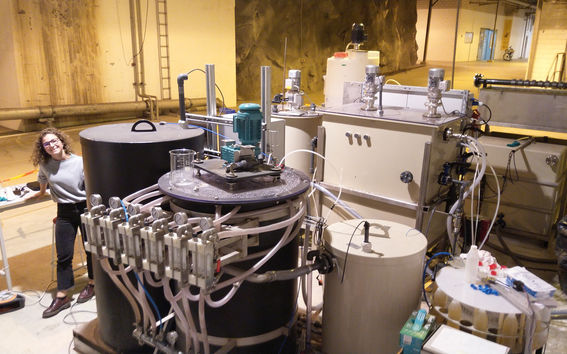Turning wastewater nutrients into fertiliser

Wastewater contains large amounts of nitrogen and phosphorus, which are valuable nutrients. NPHarvest is a process developed by Aalto University researchers that allows for the recovery of these nutrients in a way that produces a clean ammonium sulphate solution, which can be used as fertiliser, and a slurry rich in phosphorus and calcium. Using the NPHarvest process to produce recycled fertiliser can save both energy and natural resources, as it reduces nutrient discharges into waterways and cuts the amount of energy and chemicals consumed by aeration and wastewater treatment processes.
Developing a membrane
The NPHarvest process begins with the chemical coagulation of wastewater with lime dust, an industrial by-product. Coagulation allows for the harvesting of the phosphorus in the water. The separation of nitrogen in ammonium form is based on the use of a gas-permeable membrane. As an example, a biogas plant could achieve savings by using the NPHarvest process to treat its reject water on-site and turning it into fertiliser instead of conveying the water to a wastewater treatment plant and paying an increased wastewater charge.
'In the spring of this year we still had some doubts about the durability and cleaning of these membranes, as we had conducted only short-term experiments. This summer we had an opportunity to test the process over a span of several months, which also confirmed the feasibility of these membranes. We now know that the process works even in challenging environments, for example in the treatment of reject water from sludge digestion or leachate from a landfill', says Professor of Practice Anna Mikola.
Advancing circular economy with process chemicals
The strength of the NPHarvest process is that different end products can be produced from wastewater according to need. Nitrogen, for example, can be used as a general fertiliser in an ammonium phosphate form, while ammonium nitrate is used as an industrial chemical. Various organic polymers, such as starch, can be used like traditional coagulants in the recovery of phosphorus.
NPHarvest uses acid to bind nitrogen to the final product. Test runs conducted at a wastewater treatment plant in Viikinmäki also proved the feasibility of phosphoric acid for this use. In the future, phosphoric acid could be produced through the RAVITA™ process developed by HSY to recover phosphorus from wastewater.
'The customisability and adaptability of the process are important factors in the shift toward circular economy thinking, where one person's waste is raw material for another', Mikola adds.
The NPHarvest project was funded by the Ministry of the Environment and conducted in collaboration between Aalto University and its industrial partners: Industrial Water Ltd., Helsinki Region Environmental Services Authority HSY, Gasum, Biolan, Nordkalk, Kemira and Outotec.
For further information:
Professor of Practice Anna Mikola, DSc.
anna.mikola@aalto.fi
+358 40 7176 552
Read more news

Your voice gives away valuable personal information, so how do you keep that data safe?
With speech technologies becoming increasingly common, researchers want to make sure we don’t give away more information than we mean to.
Aalto in 2025: Quantum leaps, creative breakthroughs and solutions for a better life
Growth, technology and industrial renewal; human-centred solutions; health and everyday wellbeing; and enjoyable daily life and thriving communities.
Research Council of Finland establishes a Center of Excellence in Quantum Materials
The Centre, called QMAT, creates new materials to power the quantum technology of coming decades.






